
Wine Culture and Information since 2002 - Volume 22
 Wine Culture and Information since 2002 - Volume 22 |
|
Issue 30, May 2005 |
Contents |
|
|
Technological Wines |
|
Wine - as everyone knows - is the result of many factors, all being equally important and determinant, from the indispensable contribution of nature to the contribution of human intervention. Times in which many of the variables and the wine making procedures were left more or less by “chance” - relying on the fact production is the result of foregone natural phenomenon in which grape juice ferments and gets transformed into wine - belongs to a truly distant past. Whether it is true wine represents an important bond with the tradition of the places in which it is being produced, it is also true nowadays most of this cultural heritage is strongly affected by technology, wine making developments and - last but not the least - the possibilities offered by chemistry. After all - since the beginnings of wine making - wine is the indisputable result of a series of chemical processes which take place in an absolutely natural and spontaneous way. Nowadays there are truly few producers who do not make strong and continuous use both of technology and of the possibilities offered by chemistry in order to control the stability of their wines. We do not want to say wines are today the result of a sophistication and therefore detrimental to the genuineness of the products, indeed, it is opportune to remember and admit that thanks to technology, the overall level of quality in wines has increased in the last twenty years. Moreover it is still thanks to technology that in the past few years the differences between the many producers have diminished. Whereas once the probability of finding wines with evident faults was pretty frequent, today - thanks to the development of wine making technology - faults have dramatically reduced therefore contributing to the increase - in general terms - of quality in wines. Despite the use of technology contributes to improve the quality of wines, it is however opportune to remember quality is - first of all - a presupposition in which the producer believes into and decides to achieve as a goal. In this regard it can be said technology can help the producer to make higher quality wines provided the primary conditions exist. This does mean that lacking of a quality raw matter, technology cannot make miracles, it can possibly help to obtain the best possible quality from a non excellent raw matter. Nevertheless the role of technology in the production of wines is so high that frequently producers delegates to this factor most of the final result. Technology may be virtually present in every aspect of wine production, from vineyard to bottling. Moreover the use of technology allows to diminish production costs with a subsequent reduction of prices for consumers. Countries in which the extensive use of technology is not affected by traditional or productive conditions, are capable of offering wines at cheap prices while keeping a high quality level, with the exception of the cases in which are being used speculative politics. This is true for wine as well as for any other product. Is it then simply enough to invest in the most advanced technologies in order to obtain high quality wines and at cheap prices? Certainly not. Despite man has always had the presumption of being the subject constantly at the center of the universe, capable of controlling every aspect thanks to his intelligence, nothing can be done to change the events imposed by Mother Nature in the less favorable years. In the years in which the meteorological conditions do not allow the harvesting of high quality grapes, even the most modern and efficient technology used by man can simply help to get the most out from a grape, it cannot certainly make miracles. This is clearly proven in every less favorable year when the general quality of wines is evidently inferior - while considering the proper exceptions - such as in case of 2002 and 2003 in Italy. it is also true that sometimes in the cellar can be worked real and proper miracles - both with the help of technology and of chemistry - however this does not help to increase the quality of grapes when it does not exist. There can be certainly limited the consequences of a lesser quality, this is for sure, but you cannot turn a piece of iron into gold. The same can be said for environmental and climate conditions of every wine area of the world: in other words technology cannot replace the specific characteristics of every territory. It can certainly help to obtain the best possible result, but this does not mean it can be objectively considered of high quality. Wine making technology certainly is important, however it is good to remember the current quality of wines is strongly determined by what can be considered as a radical cultural and social change towards wine. Consumers ask for more quality - and possibly to a reasonable price - and this forced producers to follow this simple market law: it is being produced what can be sold. Whether most of consumers is interested in high quality products, it is then opportune to being capable of satisfying this need, even by using technology - which certainly offers an excellent support for achieving this result - but not technology only. Indeed the greatest technological revolution was done in the cultural techniques, or better to say, in using better viticultural practices, as it was better understood the quality of wine begins, first of all, in the vineyard. This concept, once used by few and passionate producers, has now become a primary need for all who really want to achieve quality. The intervention of man is undoubtedly fundamental for the production of wine, as nature - alone - does not directly offer wine from vines, and it is thanks to the contribution of man, by using his intelligence and technology, wine can be made, and of course, good wine. Man with technology and nature with its fruits are therefore equally indispensable and fundamental factors in order to obtain quality: in case one of them does not properly contribute with its indispensable role, the result will certainly not be the best. May the technology be welcome in a cellar, as well as may be welcome everything a territory and a vineyard can offer in an absolutely unique and unrepeatable way. Technology is repeatable and adaptable everywhere, territory is not.
|
||||
MailBox |
|
In this column are published our reader's mail. If you have any comment or any
question or just want to express your opinion about wine, send your letters to
our editorial or fill in
the form available at
our site.
|
| I heard chocolate can be hardly matched to wine. Is there an explanation to this? |
| José Paredes -- Santiago (Chile) |
| Chocolate is an extremely complex and rich food and, like you rightly observed, the matching with wine does not always give satisfactory results. Chocolate, or at least good chocolate, has a very long gustatory persistence and therefore it requires a wine having an appropriate persistence. Because of its qualities, chocolate is a pretty fatty food and its introduction in the mouth causes a real and proper covering of the oral cavity and therefore of taste buds. This covering avoids other gustatory sensations to be perceived and this is true - of course - for wine as well. The dilution of this covering usually requires pretty high quantities of alcohol, usually more than 17%. For this reason the best matchings with chocolate are obtained with fortified wines or with brandies. Another quality of chocolate is the strong physiological response of salivation: a condition which is balanced both by alcohol and tannins. Of course not all chocolates are the same - just like for wines - therefore these considerations are also applied according to the intensity and the organoleptic qualities of each case. In fact it could also be that certain chocolates can be matchable with some table wines, whereas in other cases a brandy would be too much. |
| What is the difference between Cognac and Grappa? I noticed there are colorless Grappas and others have colors similar to Cognac. What is the difference? |
| Alison Turner -- London (England) |
| Despite Cognac and Grappa are both considered distillates, the differences between the two are many. First of all the production area: Cognac is produced in the Charentais region, north from Bordeaux (France), whereas Grappa is exclusively produced in Italy. Another substantial difference is represented by the raw matter. Cognac is produced by distilling wine, whereas Grappa is produced by distilling grape pomace. Whereas Cognac is always being aged in cask, this is not always true for Grappa. The aging of Grappa in cask is what determines its amber color, however this practice has become common in recent times only as Grappa is traditionally distilled and consumed without being aged in any wood container. The aging in wood generally gives Grappa spicy aromas as well as a higher gustatory complexity and smoothness. The sensorial world of Grappa is amazing and rich - just like any other noble distillate - and this is also thanks to the huge improvements of distillation techniques and a higher attention on the quality of the raw matter. Whether it is true once Grappa was considered as a humble distillate, today it can be certainly considered among the best distillates of the world. |
MarsalaThe great Sicilian wine which made the history of Italian and worldwide enology, after ups and downs, in the last twenty years is finally reviving the events of its renowned and important past |
|
Despite the recent history of Sicilian enology is made of table wines, in particular reds, the fame of this region is essentially associated to a wine - complex and rich - whose history set its root in truly ancient times. Marsala, which is named after the homonymous port city in the province of Trapani, in the south-western coast of Sicily, is one of the few wines which have arrived to our days after having passed centuries of history. A history - the one of Marsala - which lived high moments of glory, as well as sad and decaying moments of oblivion, a precious and noble wine, present in the glasses of the most refined connoisseurs, which has also lived such a decay as to consider it, in the best cases, an ordinary kitchen wine. From a not truly noble recent past, Marsala - thanks to the will and passion of serious producers - has today become again a great wine, rich, complex and full of emotions, an excellent wine capable of surprising both when tasted alone as well as matched to many foods.
|
|
Tradition tells about an English merchant - John Woodhouse - who was in Marsala and discovered the local wine, then he decided to ship it in his homeland and from that moment began the great history of Marsala wine. This is the story everyone knows and which certainly tells facts really happened as well as proved by some documents. Indeed the history of Marsala should be completed by also remembering the essential origins of this wine, already known since the times of ancient Romans. Whether it is true John Woodhouse had the idea of fortifying Marsala - therefore defining the character of Marsala the way we know it today - it should be remembered Pliny the Elder cited in his works Mamertino, the renowned wine which can be considered as the ancestor of Marsala. Despite the indisputable merits of the famous English merchant on the destiny of Marsala, he was not even the first one to export this wine outside the borders of the beautiful island of Sicily. The painter Pier Paolo Rubens, enchanted by this particular wine, at the end of his stay in Italy - from 1600 to 1608 - brought some Marsala with him at Anverse.
Since the times of ancient Romans was known a strong and conciato wine produced in the territory of Marsala, a wine which certainly is to be considered as the most probable ancestor of Marsala as the “concia” technique is still used for the production of this wine. Concia is a wine making technique which was very common at the times of ancient Romans consisting in adding some cooked must to a wine, to allow its evaporation until it reduces its volume of more than one third. After periods of alternate events and fortunes, the real change for Marsala happened in 1773 when the English merchant John Woodhouse - it seems because of a storm - was forced to land his ship Elizabeth in the port of Marsala. After a visit to the local taverns, Woodhouse tried the wine which was produced in this city and he realized the similarities with the other renowned wines of those times and that were so successful in England. His commercial skill let him realize he could make huge profits out of this wine. It was more likely the wine which Woodhouse drunk was the famous Perpetuo - the father of modern Marsala - a wine aged in cask for more than 40 years and which was directly drawn off from the cask, while filling the drawn part with other aged wine. As John Woodhouse spent some time at Malaga where he learnt the technique of Moutain wine, he thought about using the same methods for the local wine of Marsala. He decided to ship some pipes of Marsala - casks having a volume of about 420 liters (110 gallons) - in England, without specifying what wine was. In order to have the wine to better stand to the stress of such a long journey, he decided to add about 8 liters of wine brandy - corresponding to about 2% - therefore defining the modern recipe for Marsala. When the ship arrived in its homeland, the English thought it was Port wine and the success was so high Woodhouse decided to move to Marsala and to start a flourishing wine making business. To support him, arrived in Sicily his brothers who, after having bought vineyards and wineries, invested a huge amount of money for the construction of the port of Marsala including the connection with the city. In other words they set everything in order to ensure the best productive and commercial condition for that wine which, in a sense, they discovered and that from Marsala become successful in every country of the world. However they also ensured good conditions for all the others who came to Marsala after them. The first one was Benjamin Ingham who established his winery near the one of Woodhouse. Ingham was described as a man having a real talent in using the intuitions of others while introducing improvements and the same did with Marsala. The success of Sicilian wine transformed Ingham from a fabric merchant to a talented Marsala producer and he had the merit - among the many - for having exported Marsala outside the European borders to Australia and to the American continent. He was also involved, since the very beginning of his business, to the improvement of the production techniques, from vineyard to bottling, and he also wrote a decalogue which must be scrupulously followed in every production stage. Benjamin Ingham also had the merit for introducing in Marsala - by importing it from Jerez - the Soleras y Criaderas system with which were obtained huge improvements for the quality of Marsala wine. Ingham had no direct heirs, therefore when he passed away and according to his will, his wine empire passed in the hands of Joseph Whitaker, another important name for the history of Marsala. It was only in 1832 an Italian finally entered the Marsala scene. Vincenzo Florio - who was from Bagnara Calabra and who owned an important commercial naval fleet - decided to invest on wine and he did it by being involved in that new wine which was so similar to the renowned Madera. He established his winery between the ones of Woodhouse and Ingham, and he was so successful he soon bought the Ingham's winery. After Vincenzo Florio other historical families were involved in the production of Marsala and among the many are mentioned Rallo (1860), Martinez (1866), Curatolo Arini (1875), Carlo Pellegrino (1880), Lombardo (1881) and Mirabella (1927). After a long period of success, also witnessed by the preferences of illustrious men such as admiral Horace Nelson and Giuseppe Garibaldi, Marsala faced in the course of 1900's a progressive decay which completely destroyed its high quality and fame. From a precious wine it became a wine considered, in the best cases, suited for cooking only, the result of wrong productive choices and deprecable speculations. It will be only after the 1980's - also thanks to the formulation of a better law which regulates its production - that Marsala reached again the high levels of the past, therefore giving back to the joy of connoisseurs a great, magnificent wine, unique and amazing like few others.
|
||||||||
|
Marsala is a fortified wine, that is a wine to which is added some wine brandy during production. According to the Italian quality system, Marsala is a Denominazione d'Origine Controllata wine (DOC, Denomination of Controlled origin) whose production is regulated by a specific disciplinary (law n. 851 of November 28th, 1984) in which are defined the types and the characteristics of each style. Marsala is in fact produced in many styles - each one being produced in other different styles - and that can also be classified according to sweetness. Despite the scarce interest that for years characterized this wine, Marsala is a very complex wine, both in the production and - above all - in tasting, probably like few other wines in the world. Talking about Marsala means - first of all - clearly specifying the style, as every Marsala can be considered as a world of itself. Before discussing the classification of Marsala, it is opportune to talk about the area in which this extraordinary wine is being produced. Marsala - according to its disciplinary - can be made in the whole province of Trapani with the exclusion of the communes of Alcamo, Favignana and Pantelleria. By considering the many styles in which the wonderful Marsala is being produced, it is good to proceed by mentioning the primary categories. Marsala - according to the way it is produced - is classified into Ambra (amber), Oro (gold) and Rubino (Ruby). This first classification also defines - as a matter of fact - the grapes allowed for the production. Marsala Ambra and Oro are produced with white berried grapes and precisely Grillo, Catarratto, Inzolia and Damaschino, alone or in different percentages. Marsala Rubino is produced with red berried grapes and precisely Pignatello, Nero d'Avola and Nerello Mascalese to which can also be added - and for a maximum of 30% - the white berried grapes allowed for the previous categories. The other important classification for Marsala is determined by aging and the alcohol volume, and precisely: Marsala Fine (Fine Marsala), minimum aging of 1 year and a minimum of 17% alcohol volume; Marsala Superiore (Superior Marsala), minimum aging of 2 years and a minimum of 18% alcohol volume; Marsala Superiore Riserva (Superior Reserve Marsala), minimum aging of 4 years and a minimum of 18% alcohol volume; Marsala Vergine or Soleras (Virgin or Soleras Marsala), minimum aging of 5 years and a minimum of 18% alcohol volume; Marsala Vergine Stravecchio o Riserva (Virgin Very Old Marsala or Reserve), minimum aging of 10 years and a minimum of 18% alcohol volume. Some categories of Marsala can also have special historical indications, a custom - it should be remembered - less and less used. In Marsala Fine it can be used the acronym I.P. (Italia Particolare, Italy Particular), whereas in Marsala Superiore can be used S.O.M. (Superior Old Marsala), G.D. (Garibaldi Dolce, Garibaldi Sweet) and L.P. (London Particular). Finally, the last detail about the classification of Marsala is about sweetness, a quality which is defined by the quantity of residual sugar present in the wine. It is defined as Secco (dry) a Marsala having a quantity of residual sugar lesser than 40 grams per liter; Semisecco (demi-sec) with residual sugar from 40 and 100 grams per liter; Dolce (sweet) when the quantity of residual sugar is greater than 100 grams per liter. The sweetness in Marsala is defined by the production technique and in particular by the quantity of mosto cotto (cooked must) and/or sifone (mistelle), ingredients which are, for example, forbidden in the production of Marsala Vergine and therefore this style can exists in the secco (dry) version only. By combining the many categories can be obtained Marsala in different styles. For example, a Marsala Superiore can be produced both in the Ambra and Oro styles, as well as in the Secco, Semisecco or Dolce styles. The definition of these categories is always mentioned in the label and - generally speaking - represents the specific name of the wine, such as Marsala Superiore Oro Secco or Marsala Superiore Ambra Semisecco.
|
||||
|
Marsala is traditionally produced with white berried grapes - Grillo, Inzolia, Catarratto and Damaschino - and only in recent times has been introduced the one from red grapes - the Rubino - produced with Pignatello, Nero d'Avola and Nerello Mascalese. Among the white berried grapes used for the production of this wine, the most noble one certainly is Grillo, responsible for the best and valuable Marsala Vergine. Catarratto is generally used to give aromas, just like Inzolia. The main difference between Marsala Ambra and Oro is represented by concia, that is the ancient practice of adding cooked must to the wine, responsible for the amber color - hence the name - and for sweetness. Cooked must is generally produced with the must of Catarratto grapes that, after having been heated (cooked) in copper boilers for about 24 hours, its volume is reduced for more than its half. Before adding it to wines, cooked must is usually aged, a procedure which also improves its characteristics. Sifone (or mistelle) is obtained by Grillo grape must from late harvest and opportunely dried. To the must is added wine brandy in order to avoid any fermentation, while keeping sweetness. It is good to remember the use of cooked must is allowed in Marsala Ambra only, whereas it is forbidden in Marsala Oro and Rubino. The production of Marsala begins with the fermentation of the must and since this preliminary procedures, the appropriate techniques are used according to the style to be obtained. In Marsala Semisecco and Dolce, the fermentation is interrupted when the appropriate quantity of residual sugar is reached, by adding wine brandy. During this phase - and according to the category - it can also be added cooked must or sifone in order to define both the color and the sweetness. Fortification of Marsala Vergine is done at the end of fermentation. It is good to remember that in this type of wine is not allowed the adding of cooked must or sifone: a characteristic which explains the origin of the vergine name. After having obtained the base wine according to the style to be produced, Marsala is transferred in casks where it will begin the aging according to the category. Marsala Vergine can also be produced by using the Soleras y Criaderas system - imported from Spain by Benjamin Ingham - a characteristic which is mentioned in the label. Marsala is an extraordinary wine - unique in the world - and which always requires the taster to use all of his or her attention in order to understand it fully. Marsala is not a wine to be appreciated absent-minded: its vast and rich world of complex aromas, of strong flavors, make this wine one of the most amazing pleasure a glass can give.
|
Comparative TastingThe study of different wines helps the improving of the taster's sensorial capacities and offers an important help to the development of olfactory and gustatory memory |
|
The exercise of wine sensorial tasting certainly is a pleasure for the expert connoisseurs - as well as for the neophyte - anyway it also represents a pretty complex practice requiring a lot of experience before getting the most out of it and the best satisfaction. The experience is the most useful quality of the taster, a quality which is obviously acquired with practice, attention, awareness, commitment and, last but not the least, with time. It is also true the process of acquiring experience can be shortened by using a good method while leaving to chance or to circumstance the least influence possible. However it is good to remember that also the occasions offered by chance and by circumstance are always useful and indispensable for the development of the taster's sensorial capacities. In other words, it is always good to get the most out of any tasting opportunity, both the ones prepared with method and logic, as well as the ones offered by informal and quick occasions, such as a visit to a winery, a wine festival or a wine fair.
One of the quality which have always impressed neophytes is the capacity - real or supposed - of professional taster to recognize the presence of a certain grape in a wine, the area of origin, the vintage and the producer. It should be remembered these spectacular qualities not only require a scrupulous and methodic study of thousands of wines, and that in most of the cases it is simply possible to recognize some qualities of the wine only, certainly the most identifying ones, such as the grape variety and the area. It is also true the style of many producers is so evident which is practically hard not to recognize it in their wines, both whites and reds. However, despite the capacities of a taster, it is possible to recognize something - and therefore a wine as well - only in case it is already known. It can be recognized, for example, the presence of Nebbiolo in a wine only in case the qualities of Nebbiolo are known. This competence - there is no alternative to this - can be acquired with the practice of Nebbiolo tasting only. Studying just one wine certainly is useful, however this study can be more efficient and positive in case a comparative method is being used. It is the comparison of two or more things - the possibility of comparing an element with another - which allows the taster to better remember its characteristics thanks to contrast or analogy relative to other factors. In this sense, comparison is an extremely useful exercise to the formation of a taster's capacities, as it allows the study of analogies and differences existing between two or more wines. For this reason it is always preferred, in educational tasting sessions, to have many samples - at least three - in order to allow the useful exercise of comparison. The goal is not to determine what sample is the best: the purpose is just to highlight the qualities and characteristics of each wine.
|
||||||||
|
Like already mentioned, the goal of comparative tasting is to highlight the differences and analogies of many wines with the purpose of comparing one to each other. This does means it will be appropriate to organize a comparative tasting by using specific criteria and that however will let tasters to achieve a result according to the goal. There can be organized comparative tastings - at least in theory - for any type of wine by choosing the samples accordingly. Of course it would make no practical or educational sense a comparative tasting of wines completely different in type, saved the case it is wished to highlight a specific quality in a clearly evident way. In this sense, it would have scarce sense to have a comparative tasting of a white wine, a red wine and a classic method sparkling wine, saved the case of highlighting the evident differences and that would however be obvious without organizing a tasting. In other words, every comparative tasting should be organized according to a specific subject and however the wines should have at least one quality in common, such as all red wines or all white wines.
|
|
A Horizontal tasting consists in the study and comparison of wines belonging to the same vintage, same area or appellation but of different producers. The wines of a horizontal tasting must scrupulously belong to the same area or appellation and type. In order to make this concept clear, in case a horizontal tasting is being organized about Cirò DOC wines - which allows the production of white, rose and red wines - it is essential all wines to belong to the very same type and it would not make much sense to compare different types together. Therefore the goal of a horizontal tasting should be the comparison of wines with similar qualities - with the exception of the producer - such as “Sagrantino di Montefalco 2000”, “Amarone della Valpolicella 1999” or “Chianti Classico 2001”. The goal of a horizontal tasting can be both the determination of the best producer as well as the study of the enological qualities of each winery, its style and the use a producer makes of a grape and of a territory.
|
|
Among comparative tastings, the vertical one probably is the most famous and it certainly is the one having a higher charm. A vertical tasting consists in the study and in the comparison of the same wine, of the same producer but belonging to different vintages. It is then a historical evaluation of the evolution potentialities of a specific winery's wine. The most interesting aspect of a vertical tasting is represented by the possibility of the study about the qualities of a single vintage as well as the evolution potentialities of a specific wine. A vertical tasting can be considered as useful in case it is made of at least three samples and a very good vertical tasting should have at least five samples. The choice of vintages can follow any criterion. There can be chosen, for example, five consecutive vintages or even vintages belonging to different decades. The goal of a vertical tasting could also be the determination of the best vintage, however it is good to remember that it does not make much sense to compare two wines whose age differs of many years as their organoleptic qualities will evidently be different, if not distant. The goal of a vertical tasting essentially is the study of the evolution potentialities over time and the qualitative reliability.
|
|
Among all comparative tasting, the diagonal one is the less common as it does not allow an efficient study because of the differences of the wines. A diagonal tasting consists in the evaluation of wines belonging to the same type and area but of different vintages and producers. In other words it is a tasting made of wines having as the only common factor of belonging to the same area or appellation. It is right this only common factor to make the diagonal tasting not very used because it does not offer good comparative opportunities of study with the exception of evaluating each wine. This is essentially because of the fact a diagonal tasting does not allow to efficiently compare the samples which make it, saved the evaluation of the evolution possibilities of the wines of a specific area.
|
|
This type of tasting offers interesting opportunity of study and comparison. Varietal tasting are defined in two types and according to the wines which make it. The first type of varietal tasting is made of wines produced with the same grape but coming from different areas, whereas the second type is made of monovarietal wines produced with different grapes and belonging to the same category, that is white berried or red berried varieties. The first type of tasting allows the study of the differences of the same grape in relation to the territory and the soil type. To this type of tasting also belong the ones done with wine samples produced with the same grape but harvested in different periods or produced by using different wine making techniques (late harvests, dried grapes, use of barrique or cask) in order to study the influence of any single factor. The second type - made of monovarietal wines and produced with different grapes - is useful for highlighting, because of the effect of contrast, the specific qualities of a single variety. This type of tasting, for example, offers a good help for the recognition of the many aromatic grapes (Muscat Blanc, Gwürztraminer, Sauvignon Blanc) as well as non aromatic or semi aromatic grapes.
|
|
As it is known, the organoleptic qualities of a wine are also determined by the territory, the quality of its soil and its micro climate. The goal of a territorial tasting is the study of the characteristics of a territory and the influence on its wines. This type of tasting is made of wines produced in the same territory, in particular a specific appellation or wine region, and however not too excessively wide. Examples of territorial tasting could include Barolo wines coming from the five main areas, Burgundy's Pinot Noir or crus of Chablis. The study of territorial tasting is extremely interesting as it allows the recognition and the comparison of the climate and geological influences of the many areas. The efficiency of territorial tasting can be increased in case all the wines making it are produced by the same winery, a condition which allows to “filter” as much as possible the influence of the wine making practices - which are in this case supposed to be homogeneous - while highlighting the qualities of a single territory.
|
|
Organizing a comparative tasting mainly depends on its goal. There can be defined two types: educational tasting and recognition tasting. The goal of educational tasting is to allow the taster to acquire the necessary knowledge useful for doing a recognition tasting, which is more difficult and requiring experience. In educational tastings the characteristics of the wine samples will be known before the beginning of the tasting. This will allow the taster to associate the qualities really perceived on the glass to the corresponding and actual wine. It is also appropriate that to this type of tasting take part more tasters - even of different experience and competence - in order to have a profitable discussion during the evaluation of any sample. Wines will be served in the glasses before the beginning of the tasting in order to allow the taster to make comparisons and to highlight analogies and differences. The goal of a recognition tasting is to exercise the capacities of a taster in recognizing a specific type of wine while trying to highlight as many characteristics as possible. For this reason recognition tastings are strictly done blind - that is by putting samples in proper bags in order to conceal both the shape of the bottle and the label - however the subject can be known. Despite a recognition tasting can be done by a group of tasters, it is essential each one of them will work in complete autonomy because in this case the goal is to exercise the taster's sensorial capacities without having any kind of support or help. The comparison and the discussion with the other participants can be done at the end of the whole tasting session. Even in this type of tasting the samples will be served in the glasses before the beginning, however - in order to make the recognition process more interesting - the tasting of each sample can be done in succession.
|
||||
Wines of the Month |
|
|
|
Score legend Prices are to be considered as indicative. Prices may vary according to the country or the shop where wines are bought |
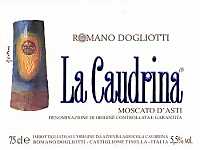
|
|
Moscato d'Asti La Caudrina 2004 |
|
| Caudrina - Romano Dogliotti (Italy) | |
| Grapes: Muscat Blanc | |
| Price: € 10.00 | Score: |
| The wine shows an intense greenish yellow color and nuances of greenish yellow, very transparent, good effervescence, fine and persistent perlage. The nose denotes intense, clean, pleasing and refined aromas which start with hints of grape and peach followed by aromas of pear, acacia, banana, litchi and sage. In the mouth has good correspondence to the nose, an effervescent attack, sweet and pleasing crispness, however balanced, light body, intense flavors, agreeable. The finish is persistent with flavors of grape, peach and litchi. This Moscato d'Asti is fermented in sealed tanks. | |
| Food Match: Cream desserts, Cream semifreddo, Soft cakes | |

|
|
Piemonte Moscato Passito Redento 2001 |
|
| Caudrina - Romano Dogliotti (Italy) | |
| Grapes: Muscat Blanc | |
| Price: € 15.00 - 375ml | Score: |
| This wine shows a brilliant amber yellow color and nuances of golden yellow, transparent. The nose reveals good personality with intense, clean, pleasing, refined and elegant aromas which start with hints of raisin, peach jam and tangerine followed by aromas of dried fig, quince jam, date, lavender, almond, honey, ripe pear, walnut, citrus fruit peel, enamel and vanilla. In the mouth has good correspondence to the nose, a sweet attack and pleasing crispness, however balanced by alcohol, good body, intense flavors, agreeable. The finish is persistent with flavors of raisin, peach jam, date and honey. A well made wine. Redento is produced with dried Muscat Blanc grapes and ages for about 18 months in barrique followed by 6 months of aging in bottle. | |
| Food Match: Hard and piquant cheese, Almond and hazelnut cakes, Confectionery | |
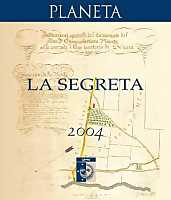
|
|
La Segreta Bianco 2004 |
|
| Planeta (Italy) | |
| Grapes: Grecanico (50%), Chardonnay (30%), Viognier (10%), Fiano (10%) | |
| Price: € 7.00 | Score: |
| The wine shows an intense straw yellow color and nuances of golden yellow, very transparent. The nose denotes intense, clean and pleasing aromas which start with hints of hawthorn, plum and apple followed by aromas of banana, pineapple, broom and pear. In the mouth has good correspondence to the nose, a crisp attack and however balanced by alcohol, good body, intense flavors. The finish is persistent with flavors of plum and apple. This wine ages in steel tanks. | |
| Food Match: Fried fish, Fish and vegetables appetizers, Eggs, Pasta and risotto with fish and crustaceans | |
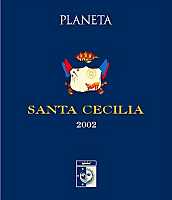
|
|
Santa Cecilia 2002 |
|
| Planeta (Italy) | |
| Grapes: Nero d'Avola | |
| Price: € 18.50 | Score: |
| This wine shows an intense ruby red color and nuances of ruby red, little transparency. The nose reveals intense, clean, pleasing and refined aromas which start with hints of plum and black cherry followed by aromas of blueberry, violet, tobacco, licorice, cocoa, vanilla, blackberry and eucalyptus. In the mouth has good correspondence to the nose, a slightly tannic attack and pleasing smoothness, however balanced by alcohol, good body, intense flavors, good tannins. The finish is persistent with flavors or black cherry, plum and blueberry. Santa Cecilia ages for 12 months in barrique. | |
| Food Match: Roasted meat, Braised and stewed meat, Hard cheese | |

|
|
Chardonnay Reserva 2003 |
|
| Punta Nogal (Chile) | |
| Grapes: Chardonnay | |
| Price: € 6.50 | Score: |
| This Chardonnay shows a brilliant golden yellow color and nuances of golden yellow, very transparent. The nose denotes intense, clean, pleasing and refined aromas which start with hints of banana and vanilla followed by aromas of acacia, apple, yeast, hazelnut, grapefruit and praline. In the mouth has good correspondence to the nose, a crisp attack and pleasing roundness, however balanced by alcohol, good body, intense flavors. The finish is persistent with flavors of banana, apple and grapefruit. This Chardonnay ferments and ages in barrique. | |
| Food Match: Mushrooms and fish soups, Stuffed pasta, Roasted fish, Roasted white meat | |
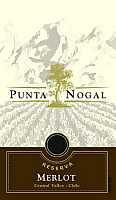
|
|
Merlot Reserva 2002 |
|
| Punta Nogal (Chile) | |
| Grapes: Merlot | |
| Price: € 6.50 | Score: |
| The wine shows an intense ruby red color and nuances of ruby red, little transparency. The nose denotes intense, clean, pleasing and refined aromas which start with hints of black cherry and plum followed by aromas of black currant, violet, vanilla, blackberry, licorice and carob. In the mouth has good correspondence to the nose, a slightly tannic attack and pleasing roundness, however balanced by alcohol, good body, intense flavors, good tannins. The finish is persistent with flavors of black cherry, plum and blackberry. This Merlot ages in barrique. | |
| Food Match: Broiled meat and barbecue, Stewed meat, Stuffed pasta | |

|
|
Barrile 2000 |
|
| Attilio Contini (Italy) | |
| Grapes: Nieddera, Caddiu | |
| Price: € 27.50 | Score: |
| This wine shows an intense ruby red color and nuances of garnet red, little transparency. The nose denotes intense, clean, pleasing and refined aromas that start with hints of black cherry and plum followed by aromas of blueberry, blackberry, vanilla, licorice, cocoa, cinnamon, tobacco and hints of menthol. In the mouth has good correspondence to the nose, a slightly tannic attack and pleasing roundness, however balanced by alcohol, good body, intense flavors, good tannins, agreeable. The finish is persistent with flavors of black cherry, plum and blueberry. A well made wine. Barrile ages for 10-12 months in barrique followed by at least 6 months of aging in bottle. | |
| Food Match: Roasted meat, Game, Braised and stewed meat, Hard cheese | |
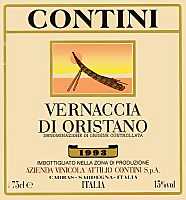
|
|
Vernaccia di Oristano 1993 |
|
| Attilio Contini (Italy) | |
| Grapes: Vernaccia di Oristano | |
| Price: € 13.20 | Score: |
| The wine shows an intense amber yellow color and nuances of amber yellow, transparent. The nose reveals intense, clean, pleasing and refined aromas which start with hints of almond and dried fig followed by aromas of honey, walnut, orange marmalade, caramel, date, licorice, lavender and hints of enamel. In the mouth has good correspondence to the nose, a slightly crisp attack and pleasing smoothness, however balanced by alcohol, full body, intense flavors. The finish is persistent with flavors of dried fig, almond, date and honey. This Vernaccia di Oristano ages in oak and chestnut casks for 10 years. | |
| Food Match: Almond desserts, Mullet botargo, Roasted meat, Hard cheese | |
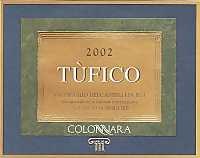
|
|
Verdicchio dei Castelli di Jesi Classico Superiore Tufico 2002 |
|
| Colonnara (Italy) | |
| Grapes: Verdicchio | |
| Price: € 12.00 | Score: |
| Tufico shows a brilliant straw yellow color and nuances of straw yellow, very transparent. The nose reveals intense, clean, pleasing and refined aromas which start with hints of hawthorn, plum and apple followed by aromas of broom, yeast, almond, pear, grapefruit and hints of mineral. In the mouth has good correspondence to the nose, a crisp attack and pleasing roundness, however well balanced by alcohol, good body, intense flavors, agreeable. The finish is persistent with flavors of plum, apple and almond. A well made wine. Tufico is produced with late harvested grapes, ages for 7 months in steel tanks followed by at least 6 months of aging in bottle. | |
| Food Match: Roasted fish, Fish and mushrooms soups, Stuffed pasta, Pasta with fish, Roasted white meat | |
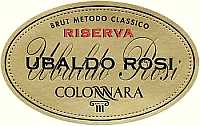
|
|
Brut Metodo Classico Riserva Ubaldo Rosi 1998 |
|
| Colonnara (Italy) | |
| Grapes: Verdicchio | |
| Price: € 20.00 | Score: |
| This wine shows a brilliant straw yellow color and nuances of straw yellow, very transparent, fine and persistent perlage. The nose reveals good personality with intense, clean, pleasing, refined and elegant aromas which start with hints of hawthorn, bread crust and yeast followed by aromas of pineapple, butter, plum, jasmine, almond, pear, apple and laurel. In the mouth has good correspondence to the nose, a crisp and effervescent attack, however well balanced by alcohol, good body, intense flavors, agreeable. The finish is very persistent with long flavors of apple, plum and almond. A well made sparkling wine. Reserve Ubaldo Rosi ages in the bottle on its lees for at least 5 years. | |
| Food Match: Roasted fish, Roasted white meat, Broiled crustaceans, Stuffed pasta with mushrooms | |
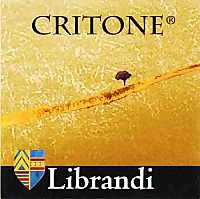
|
|
Critone 2004 |
|
| Librandi (Italy) | |
| Grapes: Chardonnay (90%), Sauvignon Blanc (10%) | |
| Price: € 6.00 | Score: |
| This wine shows a brilliant straw yellow color and nuances of greenish yellow, very transparent. The nose denotes intense, clean, pleasing and refined aromas which start with hints of hawthorn, pear and apple followed by aromas of acacia, pineapple, banana, broom and peach. In the mouth has good correspondence to the nose, a crisp attack and pleasing roundness, however well balanced by alcohol, good body, intense flavors, agreeable. The finish is persistent with flavors of pineapple, pear and peach. Critone ages in steel tanks. | |
| Food Match: Mushrooms soups, Sauteed fish, Pasta and risotto with fish and crustaceans | |
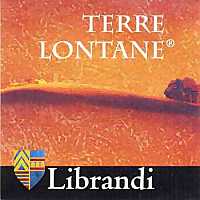
|
|
Terre Lontane 2004 |
|
| Librandi (Italy) | |
| Grapes: Gaglioppo (70%), Cabernet Franc (30%) | |
| Price: € 6.00 | Score: |
| This wine shows an intense cherry pink color and nuances of cherry pink, transparent. The nose reveals intense, clean, pleasing and refined aromas which start with hints of cherry and raspberry followed by aromas of cyclamen, strawberry, blueberry, plum, peach and rose. In the mouth has good correspondence to the nose, a crisp attack and however balanced by alcohol, good body, intense flavors, agreeable. The finish is persistent with flavors of raspberry, cherry and plum. Terre Lontane ages in steel tanks. | |
| Food Match: Legumes and mushrooms soups, Fish soups, Pasta with mushrooms, Roasted fish, Roasted white meat | |
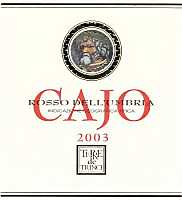
|
|
Cajo 2003 |
|
| Terre de' Trinci (Italy) | |
| Grapes: Sagrantino, Merlot, Cabernet Sauvignon | |
| Price: € 7.15 | Score: |
| This wine shows a brilliant ruby red color and nuances of garnet red, moderate transparency. The nose reveals intense, clean, pleasing and refined aromas which start with hints of black cherry, blackberry and plum followed by aromas of blueberry, vanilla, violet, licorice and tobacco. In the mouth has good correspondence to the nose, a slightly tannic attack and however balanced by alcohol, good body, intense flavors, good tannins. The finish is persistent with flavors of black cherry, plum and blackberry. Cajo ages for 6 months in cask. | |
| Food Match: Roasted meat, Braised and stewed meat, Hard cheese | |
|
|
|
Sagrantino di Montefalco Ugolino 2000 |
|
| Terre de' Trinci (Italy) | |
| Grapes: Sagrantino | |
| Price: € 25.40 | Score: |
| The wine shows an intense ruby red color and nuances of garnet red, little transparency. The nose reveals intense, clean, pleasing and refined aromas which start with hints of blackberry, black cherry and plum followed by aromas of violet, carob, licorice, tobacco, vanilla and cinnamon. In the mouth has good correspondence to the nose, a tannic attack and however balanced by alcohol, full body, intense flavors, good tannins. The finish is persistent with flavors of blackberry, black cherry and plum. Sagrantino Ugolino ages for 12 months in barrique. | |
| Food Match: Game, Braised and stewed meat, Roasted meat, Hard cheese | |
La MontinaThe prestigious winery at Monticelli Brusati - in the province of Brescia - has always been involved in the production of Franciacorta wines, to which, recently, have joined art |
|
Franciacorta - the renowned wine region of Lombardy in the province of Brescia near the Iseo lake - has achieved in the last twenty years a worldwide success for its high quality bubbles; here the production of classic method sparkling wines is to be considered among the very best of Italy and of the world. The enology of this region does not only mean sparkling wines - which, for law and coherence, must be called with the name of the area, that is exclusively Franciacorta - here the production of wine has truly ancient origins, which set their roots in the course of the history and of centuries, when the production was mainly about bruschi wines, that is lively and slightly sparkling, a characteristic which witnesses the ancient predilection of the people of this land for bubbles. Certainly at those times no one was thinking about classic method sparkling wines, however those slightly sparkling wines have certainly began the long way that now sees Franciacorta at the top of the worldwide production of charming bubbles.
At Monticelli Brusati, in the North-Eastern part of the Franciacorta region, near a natural morainic land, is located Tenuta La Montina, that in less than twenty years has been successful in reaching the top of the production of bubbles and wine tables. Tenuta La Montina - which includes the enchanting Villa Baiana - has pretty ancient origins and the first historical witnesses are dated back to 1620, at the times when the property of the estates was of a family from Valsabbia, led by Benedetto Montini - ancestor of Pope Paul VI - of whom was named after not only the whole estate but also the neighboring hill. In 1982 Tenuta La Montina was acquired by the Bozza family, that thanks to the work of Giancarlo, Vittorio and Alberto brothers, has thus continued the wine making tradition of the family. The first works were oriented to the construction of the underground cellar which extends in the underground of the hill and in which are being aged the precious Franciacorta wines. The underground cellar currently extends on an area of 4,300 mq (3.86 square miles) in which is ensured a temperature of 10-12°C (50-54°F) all year long, therefore offering the best conditions for the aging of Franciacorta. Tenuta La Montina currently owns vineyards for about 38 hectares (94 acres), located in 7 communes of Franciacorta, and cultivated in limestone and clay soils, with an average yield of 85-90 quintals per hectare (8.3-8.8 tons per hectare) and a density of 5,400-5,800 vines per hectare. The winery's vineyards are mainly located in hilly areas from which are being harvested grapes for a total yearly production of about 350,000 bottles, of which about 250,000 of Franciacorta DOCG and the remaining 100,000 of table wine and of Terre di Franciacorta - Curtefranca DOC wines. The varieties cultivated in the La Montina's vineyards are the ones allowed for the production of appellation wines of the area. Chardonnay, Pinot Blanc and Pinot Noir for Franciacorta and white Terre di Franciacorta; Cabernet Sauvignon, Cabernet Franc, Merlot, Nebbiolo and Barbera for red Terre di Franciacorta. The harvest is done in two distinct periods. In the half of August and in the beginning of September are being harvested the grapes to be used for Franciacorta DOCG in order to ensure the right levels of acidity for the production of base wines; from September to October for the grapes used for the production of table wines Terre di Franciacorta DOC.
After having traveled the French Champagne, the Bozza brothers have decided to introduce in the winery the vertical press “Marmonier” - typical of the Champagne area - constructed in the Franciacorta region thanks to the help of local artisans. The La Montina's Marmonier press has a width of 3 meters (about 10 feet) and a pretty short height in order to limit the flowing of the must while allowing a soft pressing of grapes and avoiding the breaking of the skins and therefore the release of coloring substances in the juice. The Marmonier press is located above the cellar therefore allowing the free run juice to reach the vinification tanks for the effects of gravity and without using any pump. In the cellar the must is being fermented - according to the type of wine - in steel tanks or in barriques, in which the temperature is constantly controlled. At the end of the first production phase, wines are processed according to the type of wine to be produced. Table wines follow the usual enological practices of aging, whereas the precious Franciacorta begins their journey towards the joyous foam that will lead to enchanting bubbles. Non vintage Franciacorta wines - as defined by the production disciplinary - age on their lees in the bottle for 18 months (24 months from the beginning of harvesting), whereas for millésime Franciacortas the aging in bottle will be of 36 months. The remuage of bottles is done by hand by expert cellar masters who shake and rotate bottles on a daily basis and in order to push the sediment towards the neck. The disgorgement is done by using the modern technique of à la glace, by freezing the neck of the bottle at -28°C (-18°F) with a solution of glycol. The production of La Montina's Franciacorta is valuable and of excellent quality. The range is made of many types including a Franciacorta Brut as well as a Franciacorta Extra Brut, both produced with Chardonnay and Pinot Blanc grapes. The Franciacorta Satèn - produced with Chardonnay grapes - is a truly pleasing and well made wine, probably among the best bubbles of this Franciacorta's winery. Very pleasing and interesting is also the Franciacorta Demi Sec Rosé - produced with Pinot Noir and Chardonnay grapes - very agreeable for its pleasing sweetness and crispness of its small berried fruits. The range of Franciacorta is completed by the prestigious Brut millésime - produced with Chardonnay and Pinot Noir grapes - a complex and interesting product, flagship of La Montina's bubbles. Even the table wines are very interesting and agreeable. Among whites there are Terre di Franciacorta Bianco Palanca (Chardonnay and Pinot Blanc) and Bianco Rubinia (Chardonnay). Among red wines there are Terre di Franciacorta Rosso and Rosso dei Dossi (Cabernet Sauvignon, Cabernet Franc, Merlot, Barbera and Nebbiolo) as well as the excellent Barbur, a full bodied wine in the Bordelais style. La Montina is not wine only. Since October 2004 in the rooms of Villa Baiana - which is part of the estate - is found the important Museum of Contemporary Art in Franciacorta completely dedicated to the work of the renowned artist Remo Bianco. The museum owns 400 works which are alternatively exposed in the halls and in the rooms of Tenuta La Montina and Villa Baiana. The museum has been realized thanks to the efforts of the Bozza family in strict collaboration with the painter Renato Missaglia, therefore making Tenuta La Montina a dynamic reality for the production of wine as well as a witness of that important union which more and more frequently sees wine and art joined together.
|
||||||||||||||||||||
|
Score legend Prices are to be considered as indicative. Prices may vary according to the country or the shop where wines are bought |

|
|
Terre di Franciacorta Curtefranca Rosso dei Dossi 2002 |
|
| La Montina (Italy) | |
| Grapes: Cabernet Sauvignon, Cabernet Franc (55%), Merlot (25%), Barbera (10%), Nebbiolo (10%) | |
| Price: € 6.20 | Score: |
| The wine shows a brilliant ruby red color and nuances of ruby red, moderate transparency. The nose denotes intense, clean, pleasing and refined aromas which start with hints of black cherry, blueberry and plum followed by aromas of strawberry jam, wet earth, tobacco, vanilla, licorice and cinchona. In the mouth has good correspondence to the nose, a slightly tannic attack and however balanced by alcohol, good body, intense flavors, good tannins. The finish is persistent with flavors of black cherry, blueberry and strawberry jam. Rosso dei Dossi ages in barrique. | |
| Food Match: Roasted meat, Braised and stewed meat, Hard cheese | |
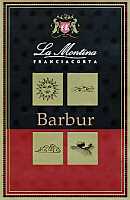
|
|
Barbur 2001 |
|
| La Montina (Italy) | |
| Grapes: Cabernet Sauvignon, Cabernet Franc (60%), Merlot (40%) | |
| Price: € 15.00 | Score: |
| This wine shows an intense ruby red color and nuances of garnet red, little transparency. The nose reveals intense, clean, pleasing and refined aromas which start with hints of black cherry, blackberry and plum followed by aromas of black currant, toasted wood, dried violet, vanilla, licorice, tobacco, mace, cocoa and menthol. In the mouth has good correspondence to the nose, a slightly tannic attack and however balanced by alcohol, full body, intense flavors, good tannins. The finish is persistent with flavors of black cherry, blueberry and plum. A well made wine. Barbur ages for 24 months in barrique followed by 12 months of aging in bottle. | |
| Food Match: Game, Stewed and braised meat, Roasted meat, Hard cheese | |

|
|
Franciacorta Brut |
|
| La Montina (Italy) | |
| Grapes: Chardonnay (80%), Pinot Blanc (20%) | |
| Price: € 10.20 | Score: |
| This wine shows a brilliant straw yellow color and nuances of golden yellow, very transparent, fine and persistent perlage. The nose denotes clean, pleasing and refined aromas which start with hints of plum, hawthorn and bread crust followed by aromas of yeast, banana, pineapple, lemon grass, hazelnut and praline. In the mouth has good correspondence to the nose, a crisp and effervescent attack, however balanced, good body, intense flavors. The finish is persistent with flavors of banana, plum and pineapple. This Franciacorta ages on its lees for 24 months. | |
| Food Match: Fried fish, Pasta and risotto with vegetables and crustaceans, Sauteed fish | |
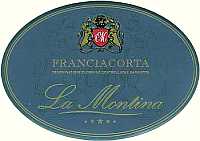
|
|
Franciacorta Extra Brut |
|
| La Montina (Italy) | |
| Grapes: Chardonnay (80%), Pinot Blanc (20%) | |
| Price: € 9.50 | Score: |
| This Franciacorta shows a pale golden yellow color and nuances of golden yellow, very transparent, fine and persistent perlage. The nose reveals intense, clean, pleasing and refined aromas which start with hints of bread crust and yeast followed by aromas of banana, hawthorn, orange, hazelnut, grapefruit, praline, apple and plum. In the mouth has good correspondence to the nose, a crisp and effervescent attack, however balanced by alcohol, good body, intense flavors. The finish is persistent with flavors of grapefruit, banana and plum. This Franciacorta ages on its lees for 24 months. | |
| Food Match: Fried fish, Pasta and risotto with fish and crustaceans, Broiled fish and crustaceans | |

|
|
Franciacorta Demi Sec Rosé |
|
| La Montina (Italia) | |
| Grapes: Pinot Noir (60%), Chardonnay (40%) | |
| Price: € 10.70 | Score: |
| This Franciacorta shows a brilliant onion skin pink and nuances of pale pink, very transparent, fine and persistent perlage. The nose reveals intense, clean, pleasing and refined aromas which start with hints of raspberry, cherry and strawberry followed by aromas of banana, cyclamen, cinnamon, yeast, tangerine, peach and rose. In the mouth has good correspondence to the nose, a crisp and effervescent attack, pleasing sweetness, however well balanced by alcohol, good body, intense flavors, agreeable. The finish is persistent with flavors of raspberry and strawberry. A well made wine. This Franciacorta ages on its lees for 24 months. | |
| Food Match: Fruit desserts, Cream desserts, Semifreddo | |
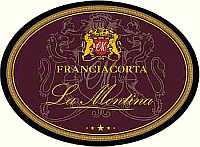
|
|
Franciacorta Satèn Brut |
|
| La Montina (Italy) | |
| Grapes: Chardonnay | |
| Price: € 15.00 | Score: |
| The wine shows an intense straw yellow color and nuances of straw yellow, very transparent, fine and persistent perlage. The nose reveals intense, clean, pleasing and refined aromas that start with hints of baked cake, banana and yeast followed by aromas of pineapple, hawthorn, bread crust, quince, grapefruit, plum and vanilla. In the mouth has good correspondence to the nose, a crisp and effervescent attack, however balanced by alcohol, good body, intense flavors. The finish is persistent with flavors of grapefruit, pineapple and plum. The base wine for this Franciacorta ages in barrique and then ages on its lees for 26 months. | |
| Food Match: Fried fish, Pasta and risotto with fish and crustaceans, Sauteed fish, Sauteed white meat | |
| La Montina - Via Baiana, 17 - 25040 Monticelli Brusati, Brescia (Italy) - Tel. +39 30 653278 Fax. +39 30 6850209 - Winemaker: Cesare Ferrari - Established: 1982 - Production: 350.000 bottles - E-Mail: info@lamontina.it - WEB: www.lamontina.it |
Cellar Journal |
|
This section is reserved to wine producers who want to publish news and information about their business, to announce new products or just for communicating to its customers information and promotions about their products and activity. Send news to be published at our e-mail address.
|
News |
|
In this section will be published news and information about events concerning the world of wine and food. Whoever is interested in publishing this kind of information can send us a mail at our address.
|
Tasting DistillatesDistillates offer rich and extraordinary qualities to the ones who can appreciate them and to the ones who decide to know them in their deepest essence, a world full of amazing aromas and flavors |
|
The exercise of distillates sensorial tasting is an interesting and amazing practice just like the one of wines. Just like for the beverage of Bacchus, the appreciation of distillates is best evident with an appropriate sensorial tasting and with the purpose of evaluating quality. Despite many distillates are usually children of the grape - just like wine - their tasting technique drastically differs from the one usually adopted for the sensorial evaluation of wine. However, the tasting of distillates and of wine have an extremely important and determinant factor in common, a quality that - alone - offers a good measure of the product's quality: aromas. Despite this common factor, the aromas of wines and of distillates are very different, for nature, intensity and quality. And the same can be said for appearance and taste: all factors which requires a proper tasting technique. The most frequent mistake wine tasters make when they are in front of a distillate is to use the same techniques for the sensorial evaluation of wine. It is frequently seen wine tasters - as well as simple wine lovers - to avidly sink their noses in the glass - just like one would do for wine - and at the same time swirling the glass while trying to search for subtle and hidden aromas, relying on the magic of oxygen. It is good to remember alcohol in distillates is present in far higher quantities than in any wine - the average alcohol volume of a distillate is of about 40% - and that alcohol volatility efficiently transports the aromas upwards even without the help of a vigorous oxygenation by swirling the glass. Another frequent mistake is the quantity of distillate introduced in the mouth: a correct tasting is made of tiny sips of about two or three milliliters; a far lower quantity than the one used for tasting wine.
|
|
The environment and the ideal conditions for tasting distillates do not differ much from the ones used for the tasting of wine: an aerated and well lighted room, absence of extraneous odors and work places with a white surface in order to allow a better evaluation of appearance. Just like for wines, it is a good practice to take note about the tasting of every distillate: to help this process have been created many analytical forms for the sensorial evaluation of distillates, just like for wine. A good taster always takes note of his or her tastings: besides forcing the sensorial analysis of a product by examining the single phases and every single aspect, it also allows to keep a historical record of the taster's activity. Even for distillates - just like for wine - a fundamental help is offered by sensorial memory, a quality which is improved with practice and experience, therefore it is always good to get the most out of any tasting.
The temperature of the samples to be tasted plays - just like in wine - an essential role for the the perception of the organoleptic qualities. On this regard it should be remembered that alcohol volatility - and therefore its ethereal and burning perception - is higher at high temperatures, whereas it is less perceivable at low temperatures. However a low temperature also penalizes the perception of other aromas, and it should be remembered alcohol volatility acts as a transport mean for all the aromatic molecules found in the distillate. As a general rule - which will be however considered for any specific case - the serving temperature for samples can range from 12°C (53°F) to 18°C (65°F): higher temperatures will make the alcohol excessively ethereal and burning therefore disturbing the evaluation. Young brandies and distillates non aged in wood containers - such as young Grappa and fruit brandies - can be served at a temperature from 12°C to 15°C (53°-59°F), whereas in distillates and brandies aged in wood casks - such as Cognac, Armagnac, Calvados and aged Grappa - the temperature can be from 16°C to 18°C (60°-65°F). A fundamental role is also played by the tasting glass. Every type of distillate should generally be evaluated in a specific glass having physical and mechanical characteristics suited for the appreciation of its organoleptic qualities. The most classic distillate glass is the so called balloon, a glass having a pretty short stem, pretty large body and volume, typical for the service of brandy and wine distillates, usually having exaggeratedly big dimensions. Indeed this type of glass excessively exalts alcohol volatility - because of the wide surface contact with air - while penalizing the perception of other aromas. No matter this glass can be considered romantic and charming, it should be better to avoid the its use for a reliable sensorial evaluation. Currently professional distillate tasting glasses tend to have a smaller volume, a smaller body which narrows towards the end - a glass usually known as tulip - with a height of about 10 centimeters (4 inches). When this glass is not available, it can be replaced by the ISO tasting glass used for the evaluation of wine.
|
||||||||
|
Every distillate - when it comes out from the alembic's refrigerant and provided it was adopted a good distillation practice - is colorless, very limpid and crystalline, with no visual fault. Paradoxically speaking, it can be said the appearance of a distillate - from this moment of the production - can only get worse because of mistakes made during the operations of alcohol reduction and aging. This operations are however necessary in order to give the distillate its organoleptic typicality and are therefore indispensable. it is being added - for example - distilled water in order to lower the alcohol volume, or it can be aged in a cask in order to give specific organoleptic qualities, such as in case of Cognac, Armagnac and aged Grappa. The mistakes that can be made in these phases of the production are generally corrected by proper cold filtering which gives an absolutely limpid and crystalline distillate. The evaluation of a distillate appearance must be considered according to its type and, in particular, color, transparency and limpidness. A quality distillate must always be very limpid, crystalline and transparent like fountain water. Suspending substances are never allowed, as well as faults in transparency or limpidness that would give the distillate a milky appearance. The evaluation of the appearance of young Grappa and fruit brandy is relatively simple: they must always be colorless, very transparent, limpid and crystalline. Things get a little bit harder for distillates aged in wood containers. It should be remembered every type of wood gives the distillate different colors, from pale straw yellow to mahogany brown, and of course according to the time of aging as well. However these color nuances can also be altered or accentuated by adding caramel, an ingredient allowed in the production of many distillates. Excluding the case of a pretty old distillate, the color will never show red hues or nuances. In case this quality is found in young distillates, it is more likely it was added an excessive quantity of caramel.
|
|
One of the fundamental pleasures of the tasting and appreciation of distillates certainly is the olfactory evaluation. With this evaluation it can be perceived the elegance, finesse and quality of a distillate. It can be clearly perceived the quality of the raw matter used for the distillation as well as the quality of the containers used for the aging. Just like for wine, even in the tasting of distillates the olfactory evaluation plays a determinant role. Before discussing the technique of olfactory evaluation, it is good to understand the effects of the main ingredient of any distillate: alcohol. As it is commonly known, ethyl alcohol is a high volatile substance and that can be cause of a pungent and burning reaction of the olfactory bulb therefore forcing the taster to temporarily stop the examination. However alcohol also transports the molecules of other aromas, therefore it plays a fundamental role in the overall perception of a distillate's aromas. The best distillates are the ones in which the burning and pungent perception of alcohol is very low while allowing the clear perception of other aromas. A distillate in which the aroma mainly perceived is the one of alcohol is not of good quality. It should be remembered this aspect is strongly influenced both by the serving temperature, as well as by the shape and volume of glass, and - of course - by the distillation practice and aging.
The aromatic nature and quality of distillates change according to the type and the production techniques. As an example, it is enough to evaluate the aromas of a young Grappa - that is non aged in cask - and of a Cognac: certainly two refined products and with pleasing and elegant aromas, and certainly two completely different products. The technique used for the evaluation of a distillate's aromas is totally and completely different from the one used for wine. A frequent mistake made by wine tasters is the one of evaluating a distillate by sinking the nose in the glass after having been vigorously swirled it. This practice is not correct for distillates because - it should be remembered - the quantity of alcohol can even be four times higher than the one usually contained in wine and therefore it is enough - without the help of a strong oxygenation - to transport the other aromatic molecules upwards. The most common technique for the olfactory evaluation of distillates usually consists in doing four distinct smells, done at different distances, and of which the first three are done without swirling the glass. The first smell is done without swirling the glass while keeping the nose at a distance of about 5 centimeters (2 inches) from the edge. This first smell is particularly useful for distillates aged in wood because it allows the appreciation of vanilla and wood aromas. The next smell will be done by placing the nose near the edge of the glass and - without swirling - it is done the second smell: in this phase will be particularly appreciated the aromas belonging to the floral family. The third smell is done - once again without swirling the glass - by placing the nose inside the glass: in this way will be particularly appreciated the aromas belonging to the fruit family. At this point the glass is moved away from the nose and it will be finally swirled, then it will be moved near the nose and therefore doing the fourth and last smell. In this phase it will be appreciated the fusion of all aromas and in particular the dried fruit, vegetal, herbaceous, floral and nuts aromas as well as the aromas passed from wood to the distillate. In all these phases the ethereal aroma of alcohol must never excessively disturb the perception of other aromas as this would be considered as a fault.
|
||||||||
|
Even during the gustatory evaluation, alcohol will play a fundamental role in the perception of the taste of a distillate. It should be remembered alcohol has a basically sweet taste, therefore it will be normal to find this sensation in distillates. In a distillate coming out from the alembic can be perceived, in variable quantities, sweet, sour and bitter tastes. Particular attention must be paid on sour taste, usually balanced by alcohol sweetness and by any possible smoothness caused by the aging in wood. Salty taste is never present in a just produced distillate, however it is possible to find it in minimum quantities because of the procedures of processing, first of all for the use of demineralized water used for reducing alcohol volume. Alcohol has a caustic effect on the oral cavity by producing the classic burning sensation, an effect which is accentuated with a higher concentration of alcohol in the distillate. The capacity of alcohol to rapidly dissolve represents a quality factor: the lesser the duration of the caustic shock, the higher the quality, finesse and elegance of a distillate. In other words alcohol, after having been introduced itself with its vehemence, it must abandon the scene in favor of other organoleptic qualities, possibly the ones already perceived by the nose. In the first phase will be introduced in the mouth few milliliters of distillate: this will allow the appreciation of the flavors and of body. It should be remembered distillates aged in wood concentrates their flavors and their body; therefore the higher the structure perceived in the mouth during this phase, the higher the time of aging in cask. On this regard it is appropriate to remember that any adding of caramel will increase the body of the distillate as well as its basically bitter and sweet taste. After that, it will be introduced in the mouth a slightly greater quantity of distillate in order to evaluate the qualities perceived in the first sip and in particular the quality of flavors, any excessive dryness - because of wood tannins - as well as sweetness. Alcohol basically has a sweet taste, however this sensation can be accentuated by adding caramel or sugar syrups, allowed for the production of some distillates and generally used in low quality products in order to round the “harshness” of a distillate. Just like for wine, it will be evaluated the intensity and persistence of flavors, while paying attention on the alcohol which will be perceived in the beginning and will rapidly dissolve. Particular attention will be paid on the final bitter taste, which will never be excessive, as well as any possible sour taste - usually covered by alcohol - and that must be scarcely perceivable.
|
||||
|
Just like for wine, even in distillates an important quality factor is expressed by the balance and harmony of every phase of tasting. Balance and harmony of a distillate are mainly expressed by its aromas and its taste. Alcohol - despite it is present in high quantities - will never disturb the olfactory and gustatory perception of a distillate. The aromas must be clean and clear, just like the execution of a symphony in which it is possible to recognize all the instruments of the orchestra. The gustatory harmony is basically expressed by the balance of flavors, where none of them will excessively prevail over the other ones and leaving the mouth in perfect balance. A mediocre quality distillate - for example - will tend to exalt a sweet taste, almost sickly, after swallowing: this could be the sign of added sugar or caramel, probably in excessive quantities. Finally it should be remembered there are many ways to age a distillate without waiting years of patient rest in a cask. In fact it can be used - in low quality distillates - huge quantities of caramel, wood chips or sugar syrups, all these to make “old” a distillate which is just few months old.
|
LicoriceThe meaning of its name is sweet root and since ancient times it was used for therapeutic uses as well as for covering the bad taste of medicines. From its roots is extracted a sweet and bitter juice having beneficial virtues |
|
Licorice, as we know it in its typical use, is an aromatic substance extracted from the roots of “Glycyrrhiza glabra”, a herbaceous plant coming from Asia and Southern Europe. The name licorice derives from Greek language and meaning sweet root. The scientific name Glycyrrhiza glabra used to refer to the licorice plant, derives from the Greek words Glykys, meaning sweet, and rhiza, that is root. Licorice, that is Glycyrrhiza glabra, is a perennial spontaneous herbaceous plant, with a big rhizome from which grow stolons up to two meters long and woody roots of the same length, belonging to the Leguminosae family, having a height from 50 to 100 centimeters (1.6-3.2 feet). Leaves are made of four-eight pairs of small leaves and a terminal leaf, flowers have a blue-violet color, with a short stem and are grouped in racemes located at the base of the leaves. Fruits are oblong coriaceous legumes, with few bristles, containing from two to six seeds of brown color. The rhizome and the roots have a brown rind and the internal part is woody and has a yellow color and a sweet taste. The parts which are used are the roots of the plant having at least three or four years. Licorice, a plant coming from South-Western Asia and South-Eastern Europe, prefers arid and untilled places, an altitude from zero and one thousand meters (0-3,280 feet). Licorice is a very vigorous plant which tends to spread both in untilled and cultivated soils, has very developed and branched roots, with underground stolons which spread horizontally and not very deep.
The period of blossoming is June-July, however the harvest is done in autumn and the part of the plant used is the root. Other plants, belonging to the leguminosae family and known as licorice include: Astragalus glycyphyllum or wild licorice, found in Europe and Siberia; Hedysarum mackenzii, roots of licorice from Canada and Alaska; Glycyrrhiza epidota, growing in Northern America and known as wild licorice. The harvest is usually done every three years - from September to November or during wintertime - and however when the vegetative cycle of the plant is resting. The harvest is done by extirpating the stolons and the roots having a diameter greater than 5 millimeters. The color of the internal part of the root is yellow. The process of extraction of licorice is long and laborious. First of all the roots, after having being harvested, are stored in a room, they are then cleaned and mashed, and in some cases processed with a special press, similar to the ones used for the pressing of olives. The mashed product is then processed with special filters and processed with hot water in order to extract the useful substances. The next phase is about concentration where the liquid mass, rich of substances, is depurated from the excessive water and stored in large containers. The part of concentrated liquid is then processed with industrial methods, according to the type of licorice to be produced. Today the process of production is almost completely mechanized, however a particular phase - in which the product must be solidified - requires the skill and the experience of the master artisan who plays a fundamental role. Craftsmanship and technology are therefore used together in order to get the best.
|
||||||||
|
The ancient Greek, Roman, Indian and Egyptian medicine made use of licorice. It is said in the tomb of Tutankhamen have been found some licorice sticks. Despite the uncertainty of this fact, it is known in the ancient Egypt, Assyria, Greece, India and China, the therapeutic properties of the root were already known. Hippocrates, Galen, Celsus and Theophrastus prescribed licorice for curing cough, to relief stomach aches, for curing renal colics and, as an ointment, to cure wounds. In Asia the properties of licorice are being used since five thousand years, as proved by the first Chinese herbarium. Traditional Chinese medicine widely use licorice as a remedy for cough, liver diseases, food intoxications and as a sweetener for preparations. In the fifteenth century the properties of licorice were introduced in Europe by Dominican monks.
|
|
The active principles of licorice are mainly represented by triterpene compounds and their derivatives, in particular glycirrizine (a substance fifty times sweeter than saccharose), flavonoids (liquiritine), phytosterols, saponin, glucose, starch and vitamins. The most important active principle is represented by glycirrizine, which is mainly concentrated in the woody parts of the plant. Licorice has digestive and gastric anti inflammatory properties, it is an excellent thirst quencher and emollient, it is used as a sedative for cough, expectorant, slightly laxative, increases blood pressure, as it causes water and sodium retention as well as a loss of potassium. For these reasons its consumption is not advised to the ones suffering from hypertension and to pregnant women. Licorice is also useful for gastritis and stomach ache, asthma and bronchitis. It is also used for the preparation of infusions. Licorice is used by the food industry, for the production of candies and chewing gums, by the liquor industry, for the production of licorice aromatized liquors or as an ingredient, and in pastry cooking. Licorice is sometimes used in the process of beer production and as an additive; it is also used in the tobacco industry, both for smoking and chewing tobaccos. The woody part of the plant is not interesting for nutritional or pharmaceutic purposes only. The extracts of licorice's active principles are also used for the production of insulating panels, for the preparation of soils to be used for the cultivation of mushrooms, to cover the soil in place of peat, and it is even used in the production of fire-proof products. Licorice, as already mentioned, is contra-indicated for people suffering from hypertension and pregnant women, to old people, kids and diabetic. Licorice should be consumed desultorily: an exaggerated consumption or the abuse of licorice may be origin of interaction with medicines and in particular with cortisone, with quinidine and other anti arrhythmic. Moreover, glycirrizine has side effects on the balance of body's mineral salts and an abuse of licorice may be cause of water retention, blood pressure increase, swelling of the face and of ankles, headache and asthenia. Licorice, besides being used by the food industry, is also used for galenic preparations, such as some types of laxatives of vegetal origin. For this reason, in many cases the licorice is consumed for long periods just because “it is a herb”. Indeed it is good to pay attention to the quantity and to the period of time in which the licorice is being consumed. It is important not to exceed the daily intake of half a gram of glycirrizine. It should be remembered licorice is to be consumed desultorily, by healthy people, from 7-8 years of age to 45-50 without serious problems, while remembering it is always good not to exaggerate or abuse.
|
||||
AquavitaeReview of Grappa, Distillates and Brandy |
|
|
| Distillates are rated according to DiWineTaste's evaluation method. Please see score legend in the "Wines of the Month" section. |
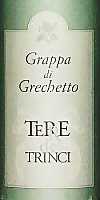
|
|
Grappa di Grechetto |
|
| Terre De' Trinci (Italy) | |
| (Distiller: Distillerie Bonollo) | |
| Raw matter: Pomace of Grechetto | |
| Price: € 12.90 - 70cl | Score: |
| This grappa is colorless, limpid and crystalline. The nose denotes intense, clean and pleasing aromas of apple, broom, pear and hazelnut with almost imperceptible alcohol pungency. In the mouth is intense with evident alcohol pungency, good balanced sweet hint, pleasing roundness. The finish is persistent with flavors of apple, pear and hazelnut. This grappa is distilled with discontinuous steam alembic still in copper boilers. Alcohol 42%. | |

|
|
Grappa di Sagrantino |
|
| Terre De' Trinci (Italy) | |
| (Distiller: Distillerie Bonollo) | |
| Raw matter: Pomace of Grechetto | |
| Price: € 14.00 - 70cl | Score: |
| This grappa is colorless, limpid and crystalline. The nose reveals intense, clean and pleasing aromas of plum, blackberry, licorice and violet with almost imperceptible alcohol pungency. In the mouth is intense with evident alcohol pungency which tends to dissolve rapidly, good balanced sweet hint, good smoothness. The finish is persistent with flavors of plum and licorice. This grappa is distilled with discontinuous steam alembic still in copper boilers. Alcohol 42%. | |

|
|
Acquavite di Mele dell'Etna 2000 |
|
| Giovi (Italy) | |
| Raw matter: Apples from Etna | |
| Price: € 35.80 - 50cl | Score: |
| This fruit brandy is colorless, limpid and crystalline. The nose denotes intense, clean, pleasing and refined aromas of apple, almond, hawthorn and broom with almost imperceptible alcohol pungency. In the mouth is intense with alcohol pungency which tends to dissolve rapidly, light sweet hint followed by a pleasing bitter taste, agreeable. The finish is persistent with flavors of apple and almond. A well made distillate. This distillate is produced with a water bath discontinuous alembic still. Alcohol 45%. | |

|
|
Grappa di Moscato di Pantelleria 2003 |
|
| Giovi (Italy) | |
| Raw matter: Pomace of Zibibbo | |
| Price: € 16.30 - 50cl | Score: |
| This grappa is colorless, limpid and crystalline. The nose reveals intense, clean, pleasing and refined aromas of grape, peach, apricot, honey, lavender, candied fruit, pear and broom with almost imperceptible alcohol pungency. In the mouth is intense with balanced alcohol pungency which tends to dissolve rapidly, pleasing and balanced sweet hint, good smoothness, agreeable. The finish is very persistent with flavors of grape, apricot, candied fruit and honey. A well made grappa. This grappa is produced with a water bath discontinuous alembic still. Alcohol 42%. | |
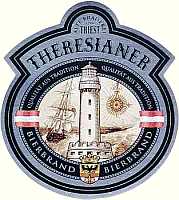
|
|
Bierbrand Distillato di Birra Theresianer |
|
| Theresianer (Italy) | |
| (Distiller: Capovilla) | |
| Raw matter: Theresianer Beer | |
| Price: n.d. | Score: |
| This distillate is colorless, limpid and crystalline. The nose reveals good personality with intense, clean, pleasing and refined aromas of hop, malt, raspberry, banana and wistaria with almost imperceptible alcohol pungency. In the mouth is intense with alcohol pungency which tends to dissolve rapidly, pleasing sweet hints followed by a balanced bitter taste, agreeable. The finish is very persistent with flavors of banana and hop. This distillate is produced with a water bath alembic still. Alcohol 41%. | |

|
|
Grappa di Enantio della Valdadige 2003 |
|
| Fratelli Brunello (Italy) | |
| Raw matter: Pomace of Enantio | |
| Price: € 24.00 - 50cl | Score: |
| The grappa is colorless, limpid and crystalline. The nose reveals intense, clean and pleasing aromas of banana, chamomile, pineapple, almond, pear and broom with almost imperceptible alcohol pungency. In the mouth is intense with balanced alcohol pungency which tends to dissolve rapidly, pleasing and balanced sweet hint, agreeable. The finish is persistent with flavors of banana, pear and chamomile. This grappa is produced with a discontinuous steam operated alembic still. Alcohol 44%. | |
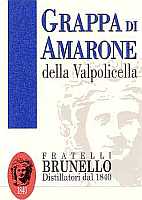
|
|
Grappa di Amarone della Valpolicella 1999 |
|
| Fratelli Brunello (Italy) | |
| Raw matter: Pomace of Amarone (Corvina, Corvinone, Rondinella) | |
| Price: € 22.00 - 50cl | Score: |
| This grappa of Amarone is colorless, limpid and crystalline. The nose reveals good personality with intense, clean, pleasing and refined aromas of black cherry, plum, blackberry, hazelnut, licorice, dried violet and hints of smoke with almost imperceptible alcohol pungency. In the mouth is intense with balanced alcohol pungency which tends to dissolve rapidly, good and balanced sweet hint, agreeable. The finish is persistent with flavors of plum, licorice and hazelnut. A well made grappa. A well made grappa produced with a discontinuous steam operated alembic still. Alcohol 40%. | |
Wine Parade |
|
|
| The best 15 wines according to DiWineTaste's readers. To express your best three wines send us an E-mail or fill in the form available at our WEB site. |
| Rank | Wine, Producer | |
|---|---|---|
| 1 |
| Riesling Cuvée Frédéric Emile 1999, Maison Trimbach (France) |
| 2 |
| Chablis Grand Cru Les Clos 2002, Domaine Billaud-Simon (France) |
| 3 |
| Harmonium 2001, Firriato (Italy) |
| 4 |
| Jerez Fino Tio Pepe, Gonzalez Byass (Spain) |
| 5 |
| Montepulciano d'Abruzzo Villa Gemma 1999, Masciarelli (Italy) |
| 6 |
| Moscato d'Asti 2003, Vignaioli di S. Stefano (Italy) |
| 7 |
| Pinot Noir Napa 2002, Clos du Val (USA) |
| 8 |
| Palazzo della Torre 2000, Allegrini (Italy) |
| 9 |
| Montepulciano d'Abruzzo Riparosso 2001, Illuminati (Italy) |
| 10 |
| Turriga 1998, Argiolas (Italy) |
| 11 |
| Edizione Cinque Autoctoni 2001, Farnese (Italy) |
| 12 |
| Amarone della Valpolicella Classico Capitel Monte Olmi 1999, Tedeschi (Italy) |
| 13 |
| Aglianico del Vulture La Firma 2002, Cantine del Notaio (Italy) |
| 14 |
| Amarone della Valpolicella Classico 1998, Santa Sofia (Italy) |
| 15 |
| Riesling Spätlese Nierstein Brudersberg 2003, Weingut Freiherr Heyl Herrnsheim (Germany) |
| |||||||
Privacy Policy | |||||||


| Copyright © 2002-2024 Antonello Biancalana, DiWineTaste - All rights reserved |
| All rights reserved under international copyright conventions. No part of this publication and of this WEB site may be
reproduced or utilized in any form or by any means, electronic or mechanical, without permission in writing from DiWineTaste. |